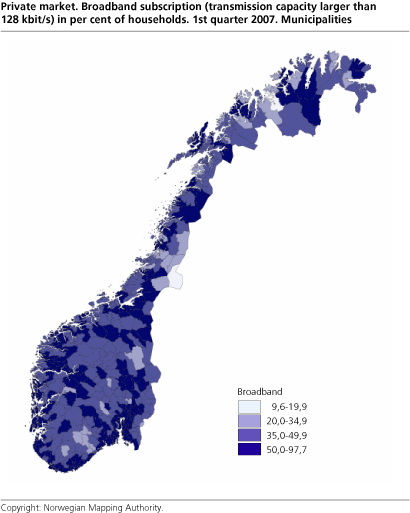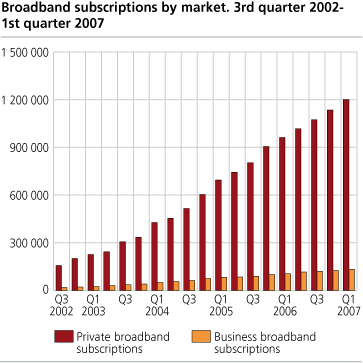Content
Published:
This is an archived release.
Broadband coverage continues expansion
The number of broadband subscriptions was 1 336 000 at the end of the first quarter of 2007, an increase of 267 000 since the end of the first quarter of 2006. Nine out of ten subscribers have a transmission capacity larger than 1 Mbit/s. Only two municipalities have less than 20 private broadband subscriptions per 100 households.
|
Revised figures in tables 1, 3 and 4 are published 23 October 2007. Please use the tables in order to find the correct figures in the article. |
At the end of the first quarter of 2007, Norway had 1 202 000 private broadband subscriptions, a 25 per cent increase since the first quarter of 2006. In the same period, the number of business broadband subscriptions increased by 27 per cent to 134 000.
87 per cent of the private broadband subscriptions have a transmission capacity larger than 1 Mbit/s. 54 per cent exceed 2 Mbit/s.
|
Private broadband subscriptions 1st quarter 2007, by centrality of the
municipality |
| Centrality1 | Broadband subscriptions | Broadband subscriptions in per cent of households | |||||||||||||||||||||||||||||||||||||
|---|---|---|---|---|---|---|---|---|---|---|---|---|---|---|---|---|---|---|---|---|---|---|---|---|---|---|---|---|---|---|---|---|---|---|---|---|---|---|---|
| Remote municipalities | 122 915 | 48 | |||||||||||||||||||||||||||||||||||||
| Fairly remote municipalities | 75 633 | 53 | |||||||||||||||||||||||||||||||||||||
| Fairly central municipalities | 283 813 | 56 | |||||||||||||||||||||||||||||||||||||
| Central municipalities | 719 022 | 64 | |||||||||||||||||||||||||||||||||||||
| 1 | Standard Classification of Municipalities, 1994 (NOS C 192). |
The most central municipalities have the highest number of broadband subscriptions relative to the number of households (64 per cent), while this figure is 48 per cent in the remote municipalities.
Only two municipalities have less than 20 private broadband subscriptions per 100 households. One year ago, 30 municipalities were in this situation. In the first quarter of 2007, 32 municipalities had between 20 and 35 private broadband subscriptions per 100 households, compared with 163 municipalities last year.
A few small, but locally important Internet service providers, mostly cable-TV providers, are still not included in the survey. Efforts have been made to include these providers. Some small errors with regard to distributing the subscribers between municipalities have been discovered. This may have strong effects on the figures per household for some municipalities.
|
Municipalities with highest number of private broadband
subscriptions in per cent of households, 1st quarter 2007 |
| Municipalities | Broadband subscriptions in per cent of households | ||||||||||||||||||||||||||||||||||||||
|---|---|---|---|---|---|---|---|---|---|---|---|---|---|---|---|---|---|---|---|---|---|---|---|---|---|---|---|---|---|---|---|---|---|---|---|---|---|---|---|
| $Average for all municipalities | 59.0 | ||||||||||||||||||||||||||||||||||||||
| 1252 Modalen | 95.2 | ||||||||||||||||||||||||||||||||||||||
| 0941 Bykle | 92.1 | ||||||||||||||||||||||||||||||||||||||
| 1835 Træna | 89.3 | ||||||||||||||||||||||||||||||||||||||
| 1121 Time | 81.6 | ||||||||||||||||||||||||||||||||||||||
| 1001 Kristiansand | 81.1 | ||||||||||||||||||||||||||||||||||||||
| 1018 Søgne | 78.3 | ||||||||||||||||||||||||||||||||||||||
| 1563 Sunndal | 76.2 | ||||||||||||||||||||||||||||||||||||||
| 0520 Ringebu | 73.8 | ||||||||||||||||||||||||||||||||||||||
| 1221 Stord | 72.0 | ||||||||||||||||||||||||||||||||||||||
| 1122 Gjesdal | 71.3 | ||||||||||||||||||||||||||||||||||||||
| 1102 Sandnes | 70.6 | ||||||||||||||||||||||||||||||||||||||
| 1124 Sola | 70.4 | ||||||||||||||||||||||||||||||||||||||
| 0219 Bærum | 70.1 | ||||||||||||||||||||||||||||||||||||||
| 0233 Nittedal | 70.0 | ||||||||||||||||||||||||||||||||||||||
| 1103 Stavanger | 69.3 | ||||||||||||||||||||||||||||||||||||||
| 1804 Bodø | 69.3 | ||||||||||||||||||||||||||||||||||||||
| 1556 Frei | 69.0 | ||||||||||||||||||||||||||||||||||||||
| 0213 Ski | 68.5 | ||||||||||||||||||||||||||||||||||||||
| 1127 Randaberg | 68.2 | ||||||||||||||||||||||||||||||||||||||
| 0906 Arendal | 67.9 | ||||||||||||||||||||||||||||||||||||||
| 0217 Oppegård | 67.8 | ||||||||||||||||||||||||||||||||||||||
| 1017 Songdalen | 67.8 | ||||||||||||||||||||||||||||||||||||||
| 0220 Asker | 67.4 | ||||||||||||||||||||||||||||||||||||||
|
Individuals and businesses may have several Internet subscriptions and several individuals may use the same subscription. The number of subscriptions is therefore not equal to the number of households/businesses with Internet access. For example, a household can get Internet access through an employer, educational institutions or by sharing access with other households. The survey on ICT in households contains more information about households with Internet access. For more information, see “ About the statistics ”. |
Tables:
- Table 1 Private broadband subscriptions. Subscription by transmission capacity and county. 1st quarter of 2007
- Table 2 Business broadband subscriptions. Subscription by transmission capacity and county. 1st quarter of 2007
- Table 3 Development features. Broadband subscription by market. Active subscriptions only. The whole country
- Table 4 Broadband subscriptions (larger than 128 kbit/s). Business and private subscriptions. 1st quarter 2007. Municipality
Contact
-
Statistics Norway's Information Centre
E-mail: informasjon@ssb.no
tel.: (+47) 21 09 46 42


